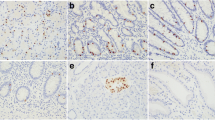Abstract
PROX1 is a homeobox transcription factor involved in the development of the lens, liver and heart and found upregulated in colorectal cancers. We studied PROX1 expression by immunohistochemistry in rectal neuroendocrine tumors (NETs). Approximately 10 to 15 % of gastroenteropancreatic NETs occur in the rectum, and some may metastasize. Yet little is known about the molecular pathogenesis of rectal NETs or their metastasis propensity. The objectives were to find out whether PROX1 plays a role in progression of rectal NETs and whether it has value as prognostic marker. In grading of rectal NETs, we applied the WHO 2010 classification. We carried out immunohistochemical staining of PROX1 on 72 primary tumors and six metastases and evaluated nuclear positivity in each tumor. Correlation between PROX1 expression, metastasis and patient survival was then assessed. Annexin A1, a downstream target of PROX1, was immunohistochemically assessed in 18 tumors. PROX1 protein was detected in about half of the tumors, with stronger expression in metastasized cases. PROX1 expression correlated with tumor metastasis and patient prognosis. Annexin A1 was negative in most of the high-grade tumors correlating strongly with grade and metastatic potential. Our results indicate that immunohistochemical detection of PROX1 correlates with a more malignant phenotype in rectal NETs. High PROX1 expression was associated with increased metastatic potential and poor patient survival but not as strongly as grade by the WHO 2010 classification. PROX1 may be involved in progression of rectal NETs as a part of the Wnt pathway.



Similar content being viewed by others
References
Oliver G, Sosa-Pineda B, Geisendorf S, Spana EP, Doe CQ, Gruss P (1993) Prox 1, a prospero-related homeobox gene expressed during mouse development. Mech Dev 44:3–16
Sosa-Pineda B, Wigle JT, Oliver G (2000) Hepatocyte migration during liver development requires Prox1. Nat Genet 25:254–255
Dyer MA, Livesey FJ, Cepko CL, Oliver G (2003) Prox1 function controls progenitor cell proliferation and horizontal cell genesis in the mammalian retina. Nat Genet 34:53–58
Petrova TV, Nykanen A, Norrmen C, Ivanov KI, Andersson LC, Haglund C, Puolakkainen P, Wempe F, von Melchner H, Gradwohl G, Vanharanta S, Aaltonen LA, Saharinen J, Gentile M, Clarke A, Taipale J, Oliver G, Alitalo K (2008) Transcription factor PROX1 induces colon cancer progression by promoting the transition from benign to highly dysplastic phenotype. Cancer Cell 13:407–419
Kinzler KW, Vogelstein B (1996) Lessons from hereditary colorectal cancer. Cell 87:159–170
Wiener Z, Hogstrom J, Hyvonen V, Band AM, Kallio P, Holopainen T, Dufva O, Haglund C, Kruuna O, Oliver G, Ben-Neriah Y, Alitalo K (2014) Prox1 promotes expansion of the colorectal cancer stem cell population to fuel tumor growth and ischemia resistance. Cell Rep 8:1943–1956
Skog M, Bono P, Lundin M, Lundin J, Louhimo J, Linder N, Petrova TV, Andersson LC, Joensuu H, Alitalo K, Haglund CH (2011) Expression and prognostic value of transcription factor PROX1 in colorectal cancer. Br J Cancer 105:1346–1351
Calender A (2000) Molecular genetics of neuroendocrine tumors. Digestion 62(Suppl 1):3–18
Niederle MB, Hackl M, Kaserer K, Niederle B (2010) Gastro-entero-pancreatic neuroendocrine tumours—the current incidence and staging based on the WHO and ENETS classification. Endocr Relat Canc 17:909–918
Ellis L, Shale MJ, Coleman MP (2010) Carcinoid tumors of the gastrointestinal tract: trends in incidence in England since 1971. Am J Gastroenterol 105:2563–2569
Tsikitis VL, Wertheim BC, Guerrero MA (2012) Trends of incidence and survival of gastrointestinal neuroendocrine tumors in the United States: a seer analysis. J Cancer 3:292–302
Modlin IM, Lye KD, Kidd M (2003) A 5-decade analysis of 13,715 carcinoid tumors. Cancer 97:934–959
Kang H, O’Connell JB, Leonardi MJ, Maggard MA, McGory ML, Ko CY (2007) Rare tumors of the colon and rectum: a national review. Int J Colorectal Dis 22:183–189
Konishi T, Watanabe T, Kishimoto J, Kotake K, Muto T, Nagawa H, Japanese Society for Cancer of the Colon and Rectum (2007) Prognosis and risk factors of metastasis in colorectal carcinoids: results of a nationwide registry over 15 years. Gut 56:863–868
Yao JC, Hassan M, Phan A, Dagohoy C, Leary C, Mares JE, Abdalla EK, Fleming JB, Vauthey JN, Rashid A, Evans DB (2008) One hundred years after “carcinoid”: epidemiology of and prognostic factors for neuroendocrine tumors in 35,825 cases in the United States. J Clin Oncol 26:3063–3072
Jernman J, Valimaki MJ, Louhimo J, Haglund C, Arola J (2012) The novel WHO 2010 classification for gastrointestinal neuroendocrine tumours correlates well with the metastatic potential of rectal neuroendocrine tumours. Neuroendocrinology 95:317–324
Jernman J, Valimaki MJ, Hagstrom J, Louhimo J, Haapasalo H, Arola J, Haglund C (2014) Cyclin A predicts metastatic potential of rectal neuroendocrine tumors. Hum Pathol 45:1605–1609
Elsir T, Qu M, Berntsson SG, Orrego A, Olofsson T, Lindstrom MS, Nister M, von Deimling A, Hartmann C, Ribom D, Smits A (2011) PROX1 is a predictor of survival for gliomas WHO grade II. Br J Cancer 104:1747–1754
Miettinen M, Wang ZF (2012) Prox1 transcription factor as a marker for vascular tumors-evaluation of 314 vascular endothelial and 1086 nonvascular tumors. Am J Surg Pathol 36:351–359
Conflict of interests
The authors declare that they have no competing interest.
Funding
This research received funding from The Sigrid Jusélius Foundation, the Finnish Cancer Foundation and Helsinki University Hospital Research Funds.
Author information
Authors and Affiliations
Corresponding author
Additional information
Johanna Arola and Caj Haglund contributed equally to this work
Rights and permissions
About this article
Cite this article
Jernman, J., Kallio, P., Hagström, J. et al. PROX1 is involved in progression of rectal neuroendocrine tumors, NETs. Virchows Arch 467, 279–284 (2015). https://doi.org/10.1007/s00428-015-1795-7
Received:
Revised:
Accepted:
Published:
Issue Date:
DOI: https://doi.org/10.1007/s00428-015-1795-7




